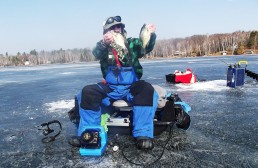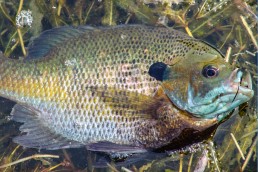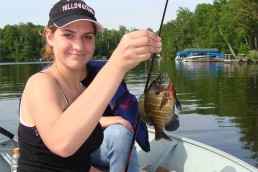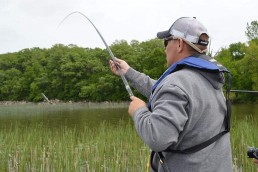Three Methods for Icing Bluegills: Simple, Modern, Scientific
SHARE THIS POST
After a successful deer season with some venison safely stashed away, an avid ice fisherman’s thoughts will probably wander to frozen aqua and all its tasty possibilities below.
Now, when one’s bones seem to get creakier and more crackly, and not necessarily at age 60, trips across the frozen tundra—and I don’t mean Lambeau Field—are much more enjoyable when the warm sun is high in the sky.
Yes, a day out on the ice should start about 10 a.m. and end at 3 p.m. And the good part about it is the ‘gills themselves bite pretty well at this time of day.
Or do they?
Perhaps anglers should search further with some scientific research, like biology, to learn about the ways of bluegills and what they eat and when.
But first let’s look at the older, simpler method of ice fishing, the newer, modern way and then the scientific method that just might turn bluegill ice fishing into a bonanza. Either way, the sweet taste of bluegills is quite the incentive.
The simple way
Some retired buddies of mine have some short pieces of broken rods with reels attached with duct tape. They walk on the ice with hand augers over their shoulders with buckets hanging off the end; some have the lightest gas augers they can buy. These guys play golf, walk to church or to the store and hunt by stalking and wandering all over the countryside. They never get lost and they hardly ever get tired.
And they catch fish.
When you ask them where they catch bluegills, they answer, “It ain’t a puzzle—in the weeds!”
These guys do use some minnows once in a while, but a snuff can full of waxworms is easy to carry. I said carry, not placed in the back of a 4-wheeler. One day last year I saw a senior gentleman walk out of the woods and proceed to a spot he must have known from memory. It was in the midst of a group of ice shacks, with a herd of trucks and snowmobiles parked helter-skelter. He took a hand auger and drilled one hole through 10 inches of ice. He had an old Mitchel reel on a short rod. He kept pulling waxworms out of his mouth where he kept them warm and wiggly, then hooked a waxy just in back of the little brown head, using nothing but a tiny hook and sinker on his line. He caught 10 big bull bluegills in about 40 minutes, smiling as they came up the hole. He wrapped those ‘gills in a bread wrapper he had stashed in an old beat-up knapsack. The knapsack was attached to a small, aluminum folding chair. He paused, pulled out and ate a peanut butter and jam sandwich.
A group of young whippersnappers were there, milling around.
“I got supper,” he told them. “They’re down there, go git ‘em.”
He scratched his trim, white beard, marched off the ice at a quick pace and disappeared into the woods.
A very, experienced “fishbrain”—yep.
The modern way
Don’t get me wrong. I fish simply with nothing but the aforementioned tools, but I also hand-pull a small, plastic Jet Sled across the ice. It’s wide enough and long enough so that my new 8-inch Jiffy just sticks out the back end. I’m kind of a young dinosaur. I have a friend who is breaking me into the ways of the modern ice-angler. Wow! Is there ever some neat stuff on the market.
I saw a pole attached to a bent, circular frame so it sits nicely on the ice, and is ready to grab and set the hook—got one of them.
Are you enjoying this post?
You can be among the first to get the latest info on where to go, what to use and how to use it!
My wife went Christmas shopping last year after Thanksgiving, telling me there were sales—Huh? I talked her into a Gander Mountain visit, and lo and behold, a powder blue, one-man ice shack was drawing me in. It was magnetic magic. This invention sets up fast, has its own sled, a few windows and even a tray to put hooks, sinkers, jigs, pliers, jaw spreaders, etc., into it. But the neat thing was a seat with a cushioned back that moves back and forth—scha-zaam! After a discussion with Suzy—and remembering that my Mom told me long ago I ought to settle down, buy a house—I came to a compromise. Suzy was now laughing, and I paid half and got one of those blue ice shacks.
My buddy, who is also a fisheries biologist so I gotta listen to him, said, “Dock. You gotta get a Vexilar or one of those fish finders that keep you from talking to yourself,” he said. “You can talk to a machine like you talk to the TV.”
He then showed me how they work. By God, they show your jig right on the screen going up and down and the bluegills coming into the action, and oops—setting the hook—got one of them!
I don’t have a portable heater or lantern that kind of heats up the place, but with the modern, lightweight winter gear these days, I can see myself sitting there in comfort. But first, after Thanksgiving dinner this year when we’re all filled up and burpin’,
I’m gonna ask without seeming too anxious if we could do some shopping. If everything goes my way, and I ask what Suzy wants for Christmas: Honey, how about a few hints?
There’s a good chance I’m going to say by the time the ice hardens and Christmas rolls around, Hey, I got IceArmor duds and a heater, and I’m very grateful for all of them.
The scientific way
Didn’t think this old dog could learn new tricks. But when it comes to fishing, I’m all ears. Seems this Dave Genz guy is quite the ice fisherman. I read a few articles about some critters called phytoplankton and zooplankton.
Zooplankton are tiny animals; phytoplankton are tiny plants. Zooplankton eat the phytoplankton. Under the cover of ice, panfish eat a variety of burrowing insects but mainly zooplankton.
The theory is that zooplankton or microorganisms evolved and learned to hide from predators during the day. Then they rise to feed on phytoplankton when it gets dark. But plankton-eating fish are sight-feeders, needing decent visibility. I believe that bluegills will bite until pitch dark, perch quit feeding at dark and crappies, with those walleye-type eyes, keep on “trucking” and eat after dark.
So what we have here are vertical migrations that occur as it gets dark in the evening, and when it gets light in the morning. Bluegills rise as darkness falls, to feed on the increasing masses of zooplankton that ascend in the water column to feed near the surface where the phytoplankton is. As light comes in the morning hours, the reverse scenario takes place.
Bluegills also must avoid pike and other predators during the day, so they hide in weeds, in holes or suspend at safer levels. They stay on the bottom for the most part—and given the right bait—they will eat. Bluegills will eat heartier on cloudy days, at least in my experience.
Therefore, don’t give up on these hours. Let’s just say once again the peak time is early morning and late afternoon.
So can you catch bluegills at 10 a.m.? I have and will again with the right bait and by drilling lots of holes in ice above the weeds where the bluegills are hiding from pike, walleyes and muskies.
There are key sunfish ice fishing spots in a lake and there is a prime time and low-light time—all these new modern devices do help in the chase. A GPS of your favorite spots can help too.
I just looked at my retirement fund going on a downward trend. Also, a few from our ice fishing gang seem to get lost once in a while. But the fact is, if you don’t get any older, you’re dead. So I’m going fishing next week with a new GPS so I can say, I’m not lost yet—I got one of those, you bet.”
MWO
SHARE THIS POST
Did you enjoy this post?
You can be among the first to get the latest info on where to go, what to use and how to use it!
Robert Dock Stupp
MidWest Outdoors works with more than 200 outdoor experts each year, who contribute articles based on their areas of expertise. MidWest Outdoors magazine offers more fishing and hunting articles than any other publication!



